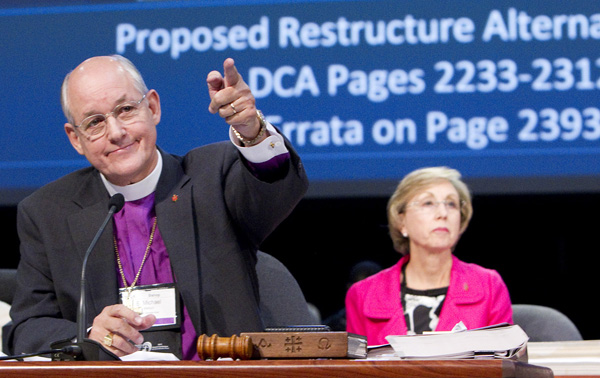Methodist General Conference delegates agree on new structurePosted May 3, 2012 |

North Georgia Bishop B. Michael Watson presides over a May 2 debate on church restructuring at the 2012 United Methodist General Conference in Tampa, Fla. At right is Bishop Janice Riggle Huie of the Houston Area. UMNS photo/Mike DuBose.
United Methodist News Service – Tampa, Fla.] After several false starts to create a new structure, the May 2 session of the United Methodist Church’s 2012 General Conference approved a modest realignment of the 13 general agencies that serve the 13 million-member denomination.
The Rev. Scott Campbell, a pastor in Cambridge, Mass., called for a declaratory decision from the Judicial Council on whether any part of the structure plan is unconstitutional. The request was granted, 505-344, well in excess of the required 20 percent of the delegates.
Costs of the new structure will be evaluated by the General Council on Finance and Administration and the Connectional Table for a final vote during the May 4 closing session.
The plan retains GCFA and four general program boards — Higher Education, Global Ministries, Church and Society and Discipleship.
The general commissions on the Status and Role of Women and Religion and Race will be combined as a Committee on Inclusiveness no later than June 30, 2013. An effort to continue the two commissions failed, 459 to 453.
That committee and the four program boards will report to a 45-member General Council on Strategy and Oversight. The top executives of those agencies will be nominated by the boards and elected by the council. If there is a conflict between guidance of a top executive of the council and the governing body of the agency, the agency executive should follow the directions of his or her board of directors.
The council will elect an executive general secretary who cannot be a bishop.
The Commission on Archives and History will be changed to a committee of the finance agency before June 30, 2013. The general director will be an associate general secretary of the council.
As established in an early plenary session, United Methodist Women will become an independent agency to join United Methodist Men, the Board of Pension and Health Benefits, the United Methodist Publishing House and United Methodist Communications as agencies that will report to General Conference. Executives of those agencies will be nonvoting members of the General Council on Strategy and Oversight.
The Commission on Christian Unity and Interreligious Concerns will become an office of the Council of Bishops by June, 30, 2013.
Plan architects
The plan, dubbed the Plan UMC, evolved from conversations between members of the legislative committee of the Connectional Table and delegates who submitted “Plan B” at the General Administration Legislation Committee during the first week of the conference.
Authors of a proposed restructuring plan from the Methodist Federation for Social Action said they were not consulted.
While the names of the 18 people drafting Plan UMC were listed in the Daily Christian Advocate, several delegates wanted to know about their conference, age and ethnicity before voting on a motion to refer. That information was not available at the time of voting.
The Rev. Tracy Malone, a delegate from Northern Illinois, argued in favor of referral. “There has been little time for delegates to consider the plan, and it was not published in other languages.” She also said there was not broad representation of youth, women and members of central conferences on the writing team.
“The time is now,” argued Evan Drexler, a delegate from Susquehanna Conference, speaking against referral. “The world is waiting to see what we are going to do to save The United Methodist Church.”
The motion to refer the proposal to the Connectional Table for further study was defeated, 395 to 555. The structure was approved 567 to 384.
Proposed amendment referred
The denomination’s Constitution carries a paragraph stating that no “organizational unit of the Church shall be structured so as to exclude any member or any constituent body of the Church because of race, gender, color, national origin, status or economic condition.”
The Commission on the Status and Role of Women asked the conference to begin steps to amend the Constitution to add “gender” to the list, and the assembly added the word “age” to the list of characteristics that cannot used to prohibit membership or attendance.
By a squeaker vote, 443-439, delegates agreed to refer the proposal to the Commission on the Status and Role of Women for further study.
Earlier UMNS coverage of General Conference’s actions on restructuring is here.

Social Menu